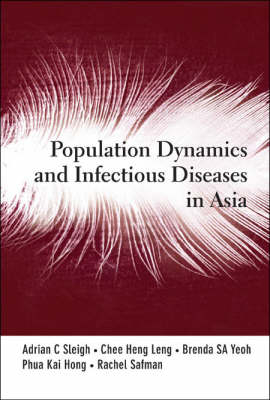
Population Dynamics And Infectious Diseases In Asia
Seiten
2006
World Scientific Publishing Co Pte Ltd (Verlag)
978-981-256-833-5 (ISBN)
World Scientific Publishing Co Pte Ltd (Verlag)
978-981-256-833-5 (ISBN)
Stimulated by a scholarly workshop convened in Singapore in late 2004, this volume considers the potentially lethal pattern of infectious disease emergence in Asia. It explores the causes and consequences of infectious agents in the region historically and examines such newly emergent natural biological threats as SARS and avian influenza.
Initially stimulated by a scholarly workshop convened in Singapore in late 2004, and written over the subsequent 18 months, this volume considers the potentially lethal pattern of infectious disease emergence in Asia. It studies linkages to changes in patterns of human activity, including but not limited to shifts in the distribution and concentration of human settlements and the patterns of movement within and between them. It explores the causes and consequences of infectious agents in the region historically and examines such newly emergent natural biological threats as SARS and avian influenza.Drawing on a range of disciplinary perspectives, the book contains analyses rooted in the social, physical and biological sciences as well as works which span these fields. Among the issues considered are the ways in which changes in our natural and built environment, social and economic pressures, shifting policies and patterns of collaboration in responding to disease impact upon our approach to and success in containing serious threats.Infection control has moved beyond the province of clinical experts, epidemiologists and microbiologists, into the mathematics of epidemic prevention and control, as well as the overall physical and human ecology and historical contexts of emerging infections. Not only does such a broad approach enable appreciation of complex forces driving growing epidemic risks in Asia today, it also reveals the importance and relevance of population dynamics, as well as the global urgency of alleviating unsatisfactory health conditions in Asia. The topic and the broad approach has international appeal beyond the region as many of these forces operate throughout the world.
Initially stimulated by a scholarly workshop convened in Singapore in late 2004, and written over the subsequent 18 months, this volume considers the potentially lethal pattern of infectious disease emergence in Asia. It studies linkages to changes in patterns of human activity, including but not limited to shifts in the distribution and concentration of human settlements and the patterns of movement within and between them. It explores the causes and consequences of infectious agents in the region historically and examines such newly emergent natural biological threats as SARS and avian influenza.Drawing on a range of disciplinary perspectives, the book contains analyses rooted in the social, physical and biological sciences as well as works which span these fields. Among the issues considered are the ways in which changes in our natural and built environment, social and economic pressures, shifting policies and patterns of collaboration in responding to disease impact upon our approach to and success in containing serious threats.Infection control has moved beyond the province of clinical experts, epidemiologists and microbiologists, into the mathematics of epidemic prevention and control, as well as the overall physical and human ecology and historical contexts of emerging infections. Not only does such a broad approach enable appreciation of complex forces driving growing epidemic risks in Asia today, it also reveals the importance and relevance of population dynamics, as well as the global urgency of alleviating unsatisfactory health conditions in Asia. The topic and the broad approach has international appeal beyond the region as many of these forces operate throughout the world.
Frameworks for Understanding Population Dynamics and Infectious Diseases in Asia; Development and Infectious Diseases in Asia; Population Mobility and Infectious Diseases in Asia; Comparative Perspectives on SARS in Asia; Drawing Lessons from the Past to Respond to Future Challenges.
| Verlagsort | Singapore |
|---|---|
| Sprache | englisch |
| Themenwelt | Studium ► Querschnittsbereiche ► Epidemiologie / Med. Biometrie |
| ISBN-10 | 981-256-833-6 / 9812568336 |
| ISBN-13 | 978-981-256-833-5 / 9789812568335 |
| Zustand | Neuware |
| Informationen gemäß Produktsicherheitsverordnung (GPSR) | |
| Haben Sie eine Frage zum Produkt? |
Mehr entdecken
aus dem Bereich
aus dem Bereich
ein überfälliges Gespräch zu einer Pandemie, die nicht die letzte …
Buch | Hardcover (2024)
Ullstein Buchverlage
24,99 €


